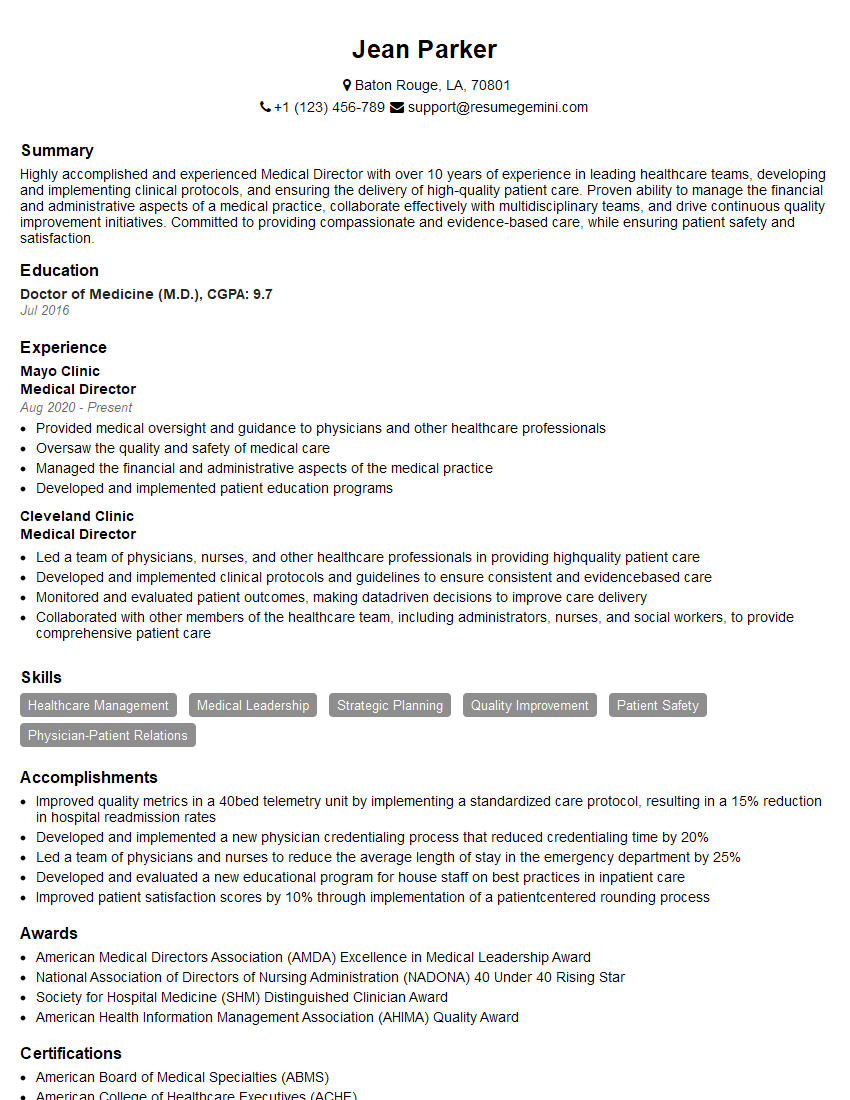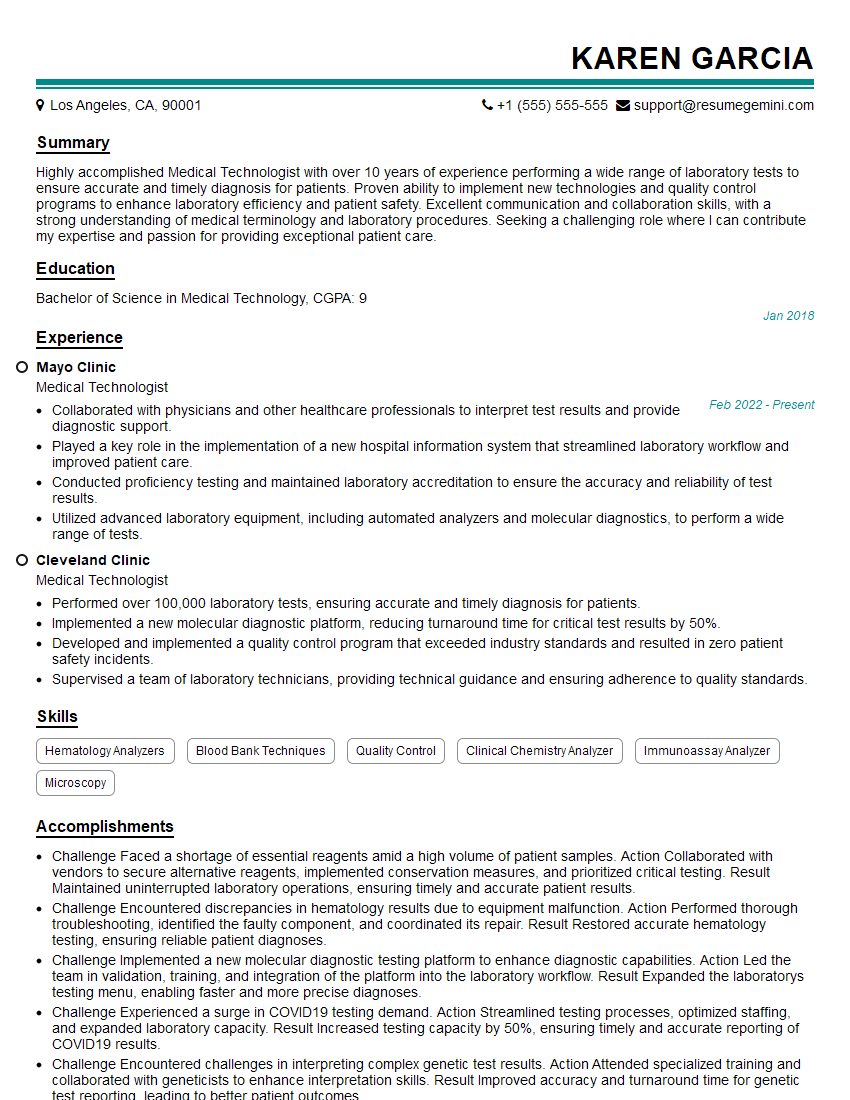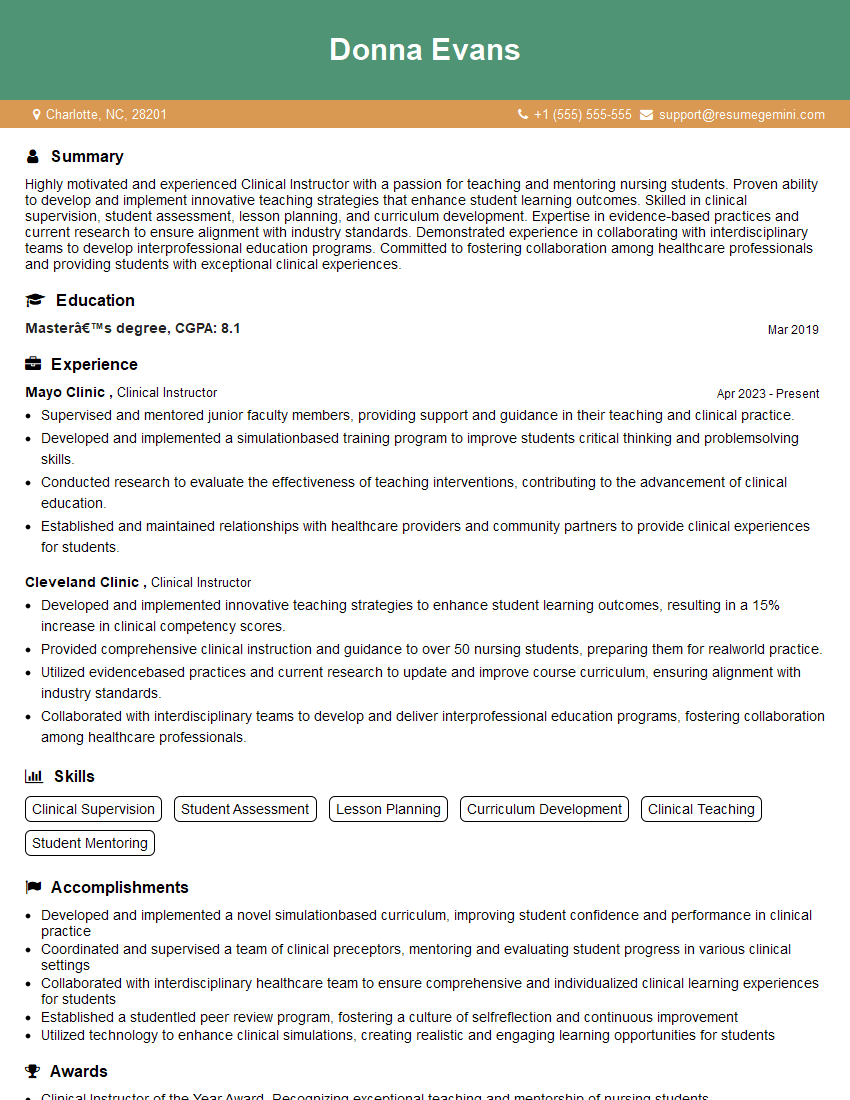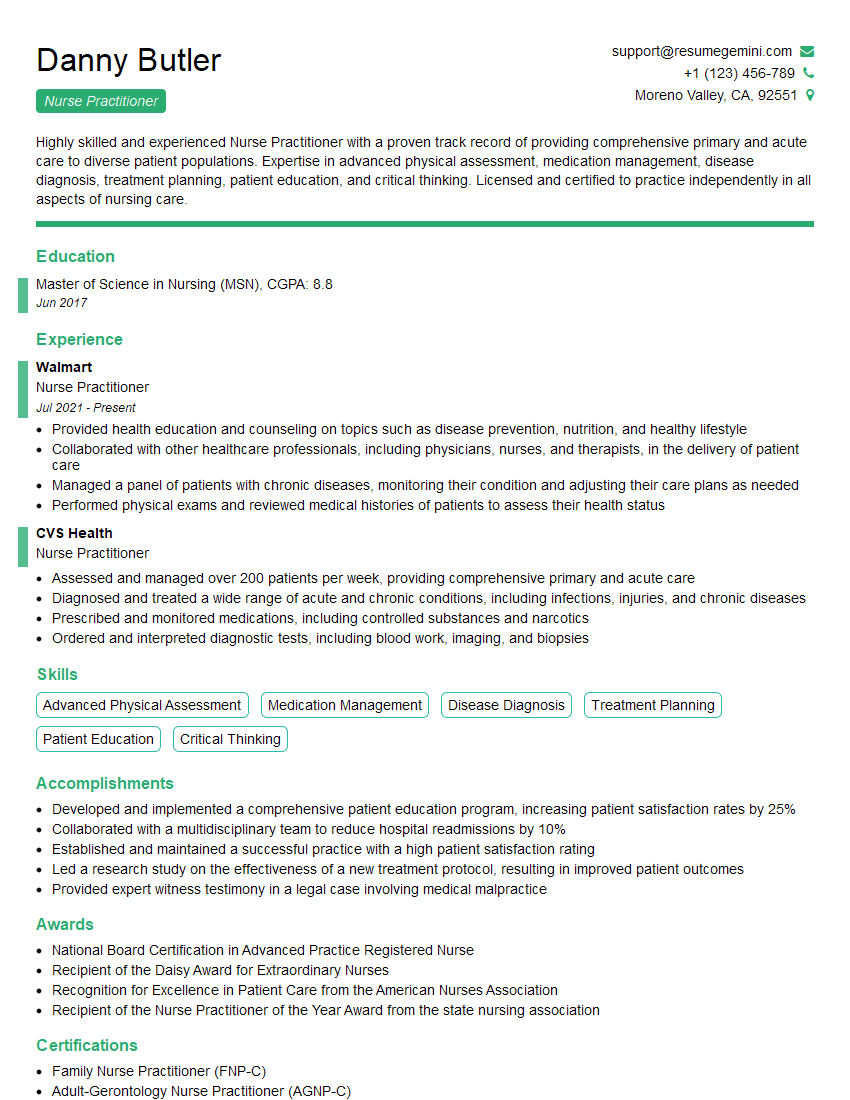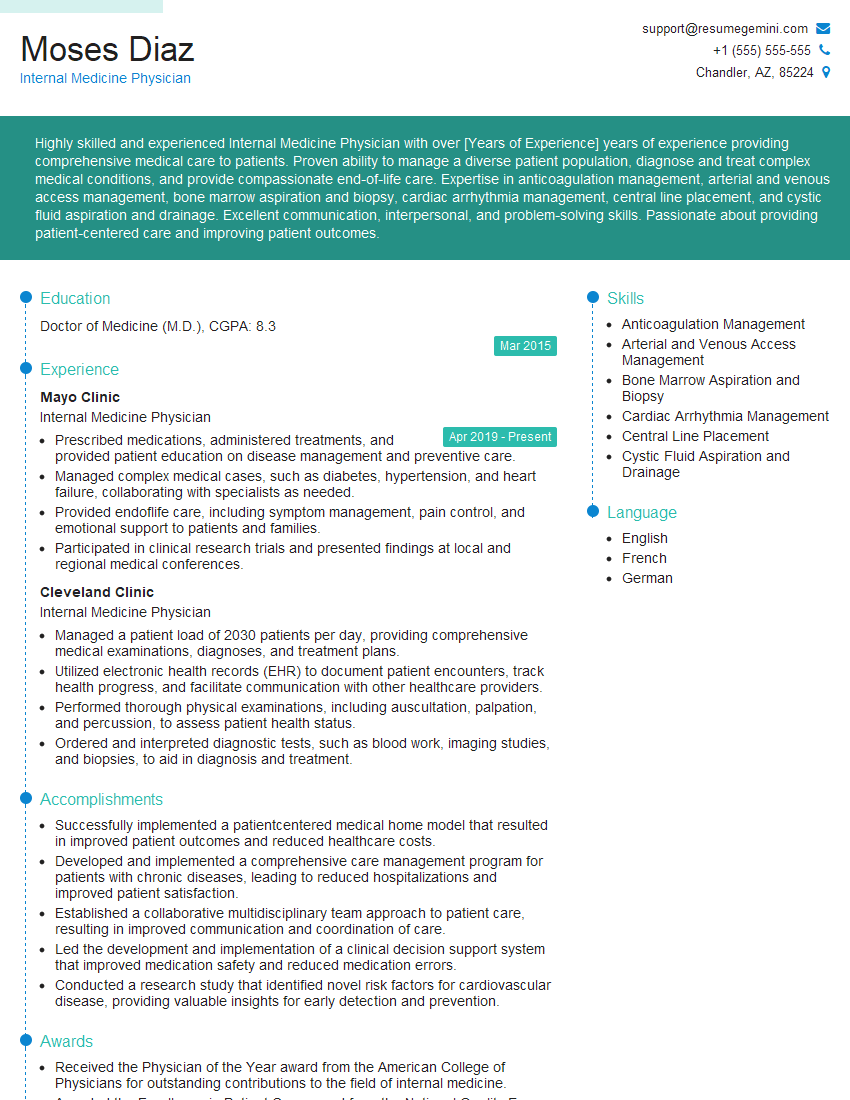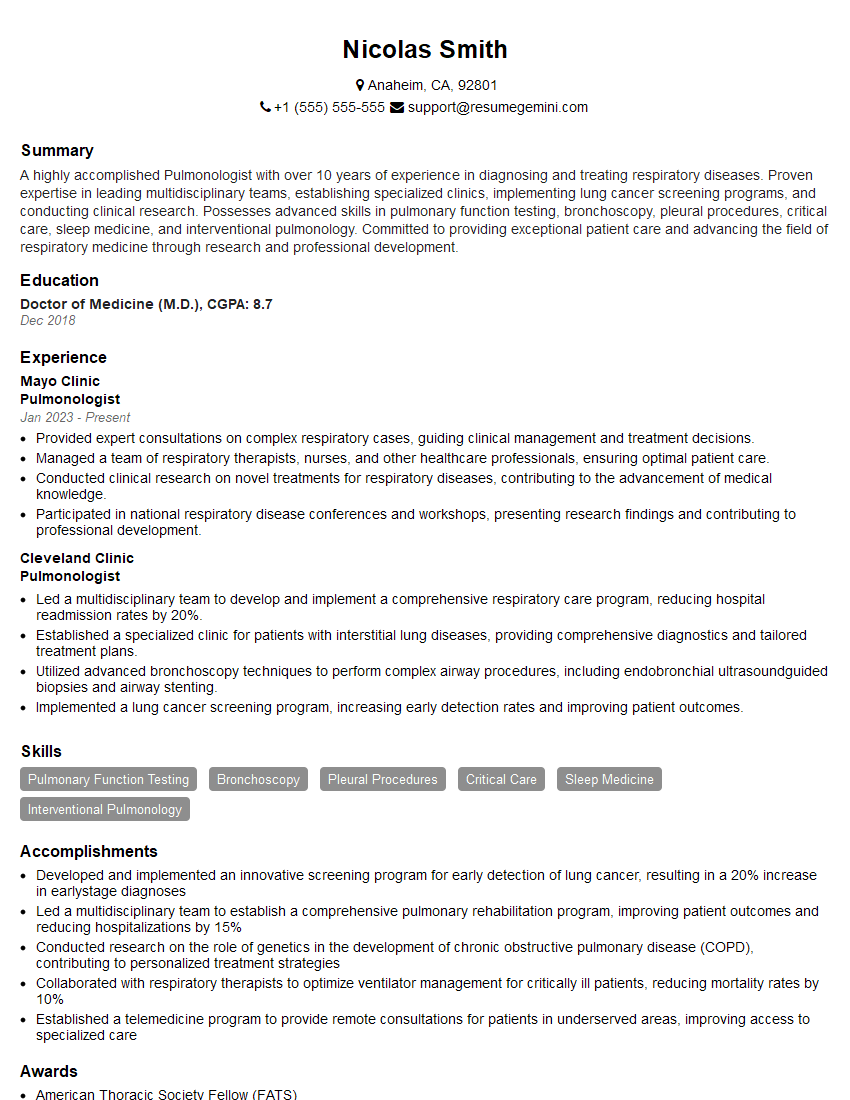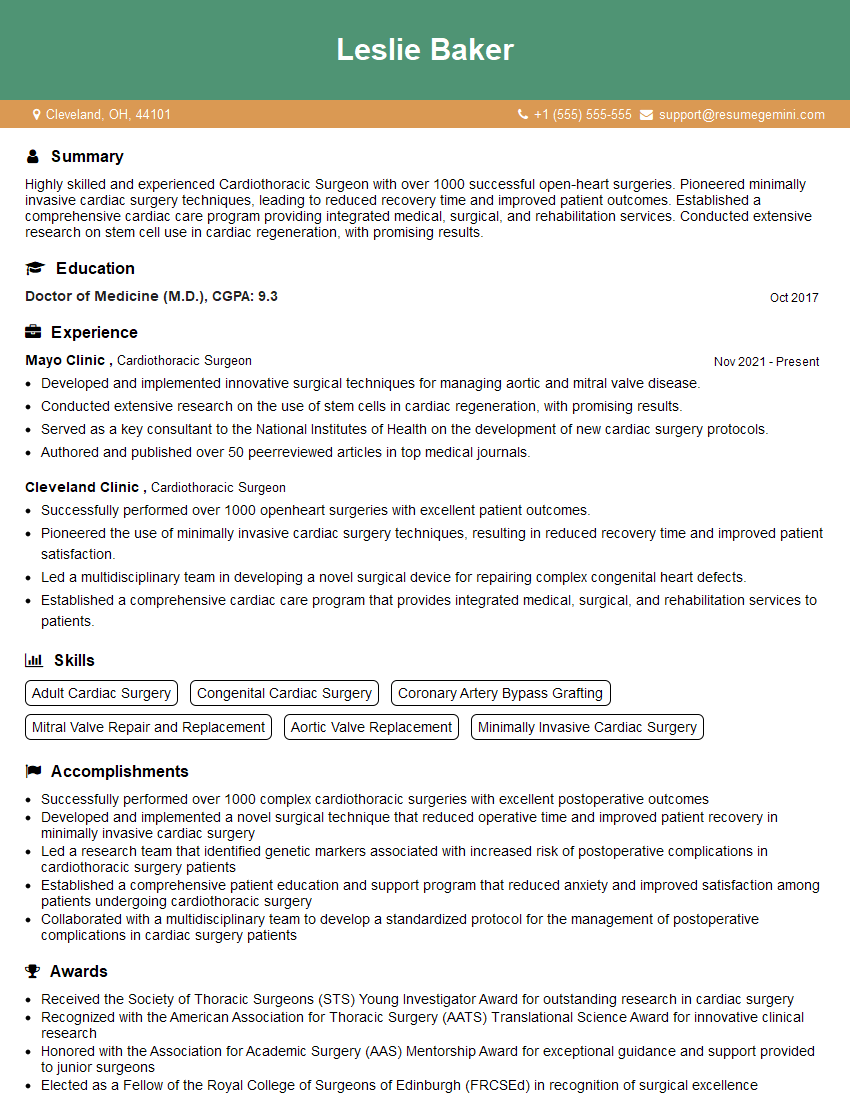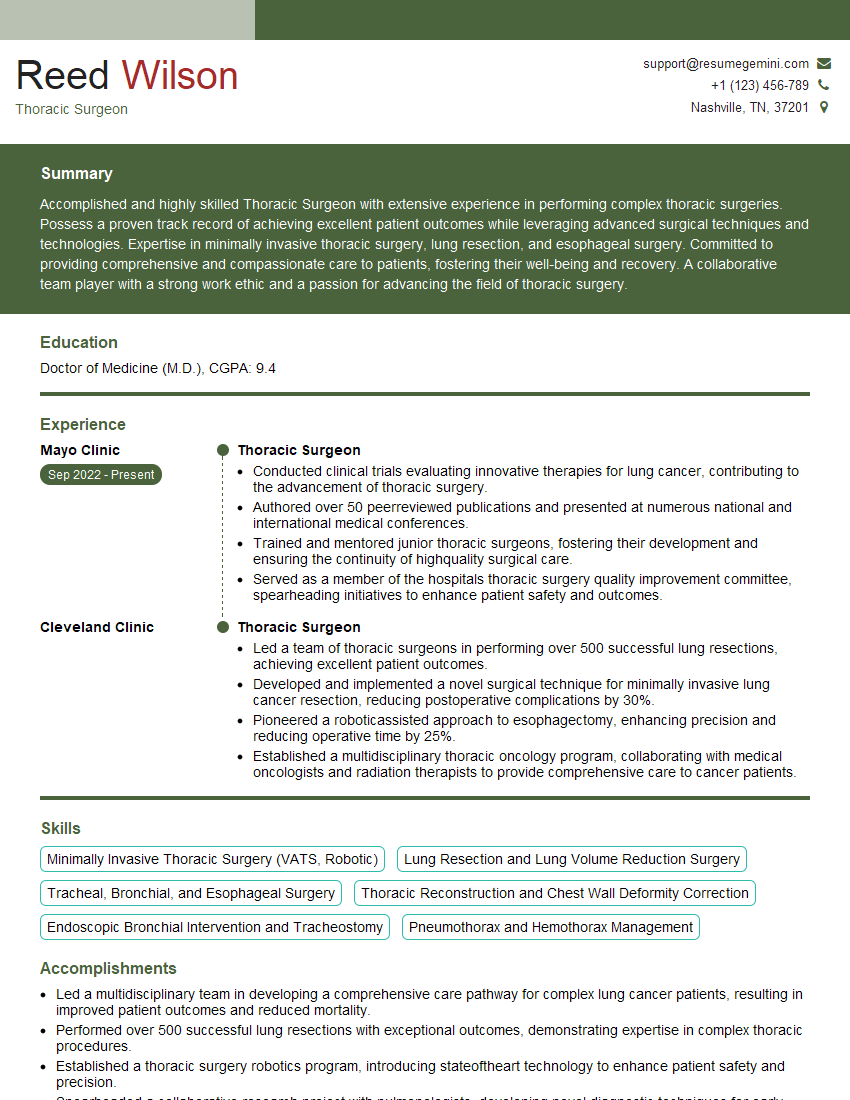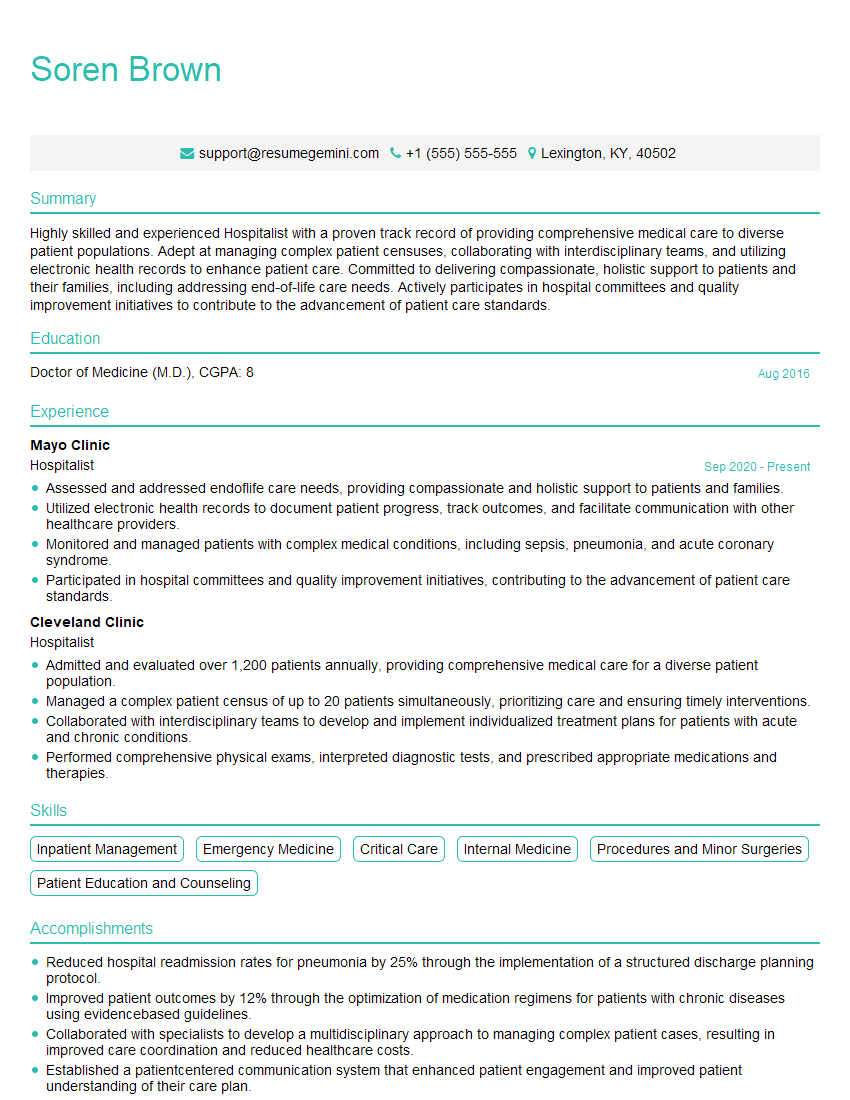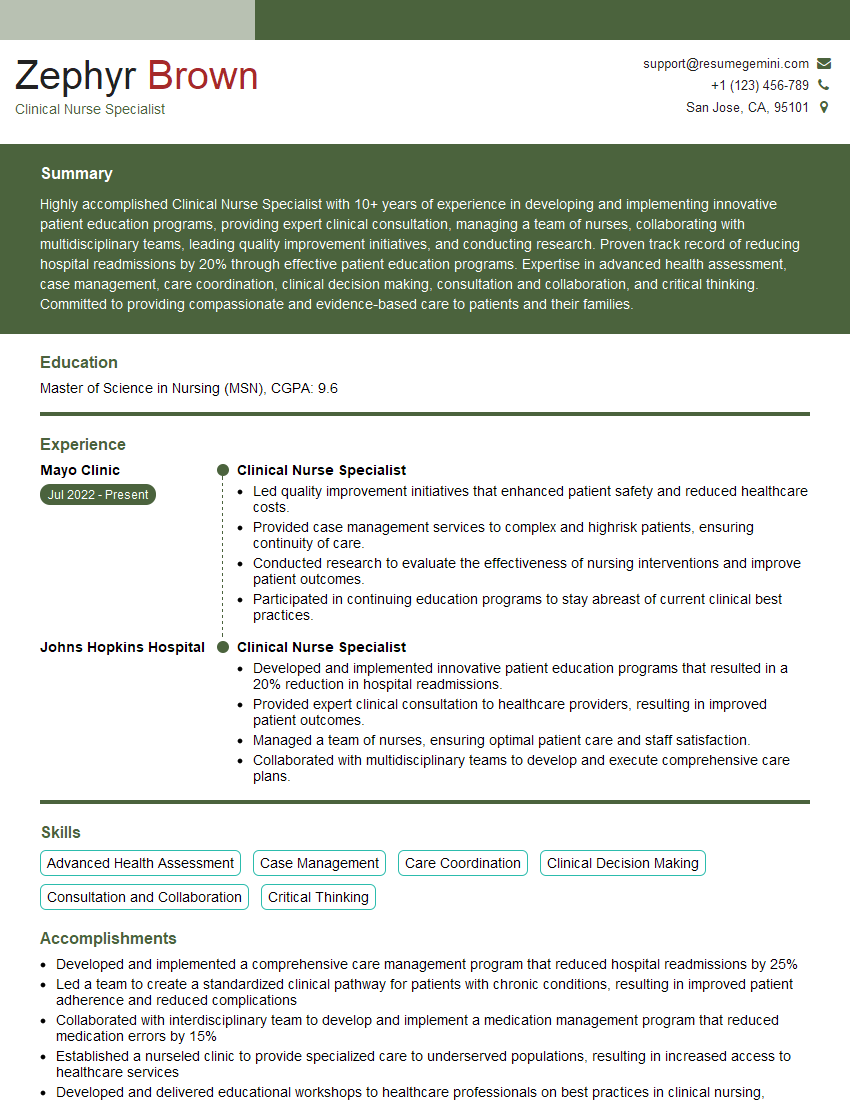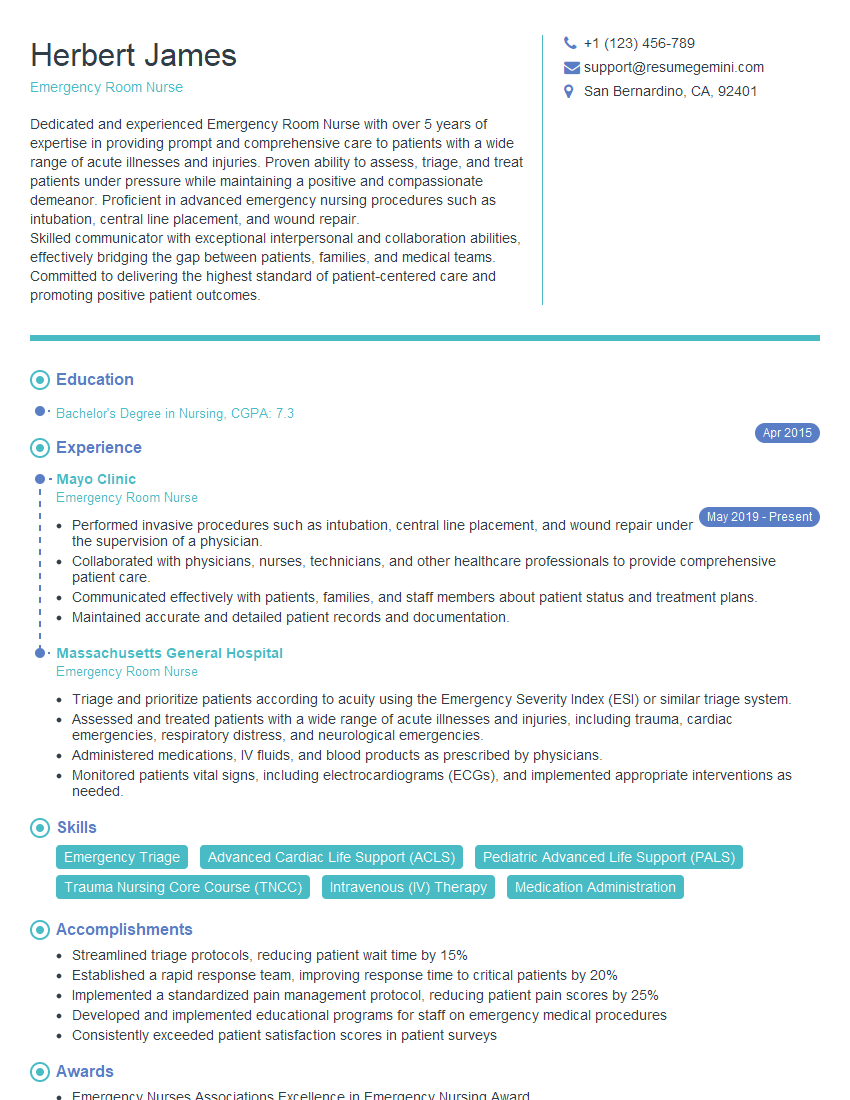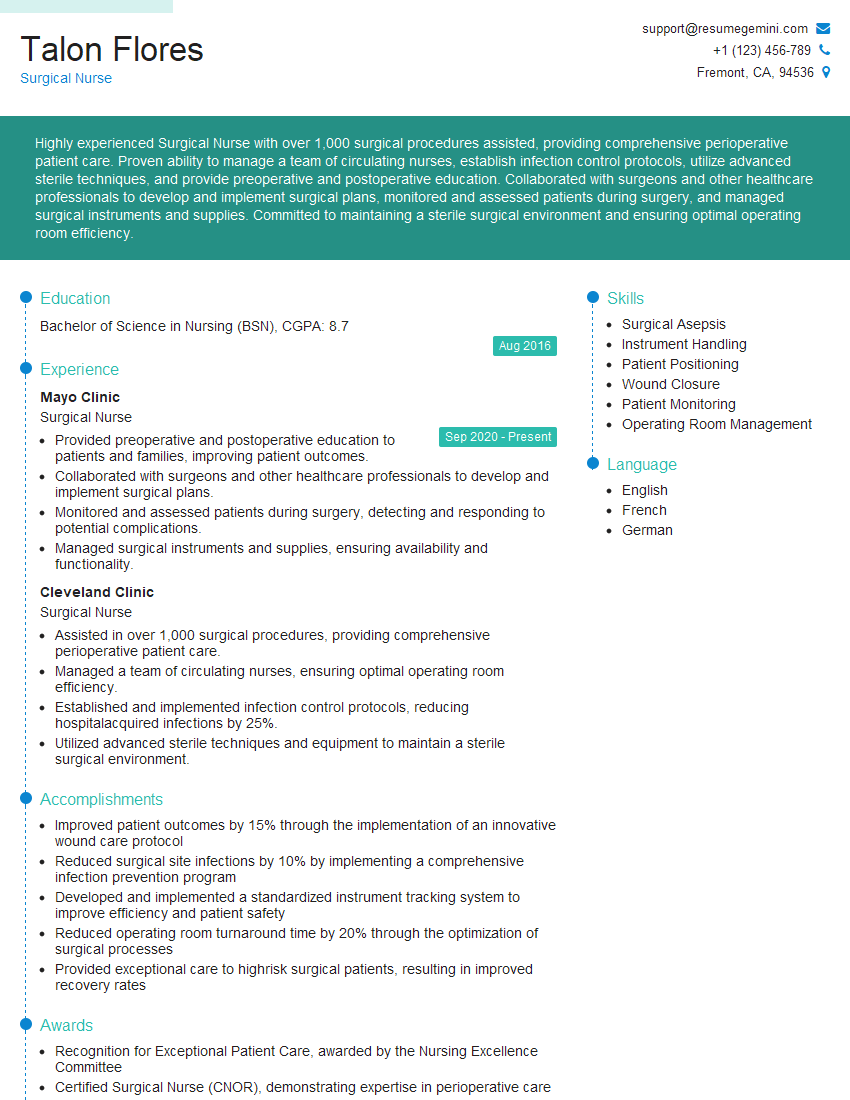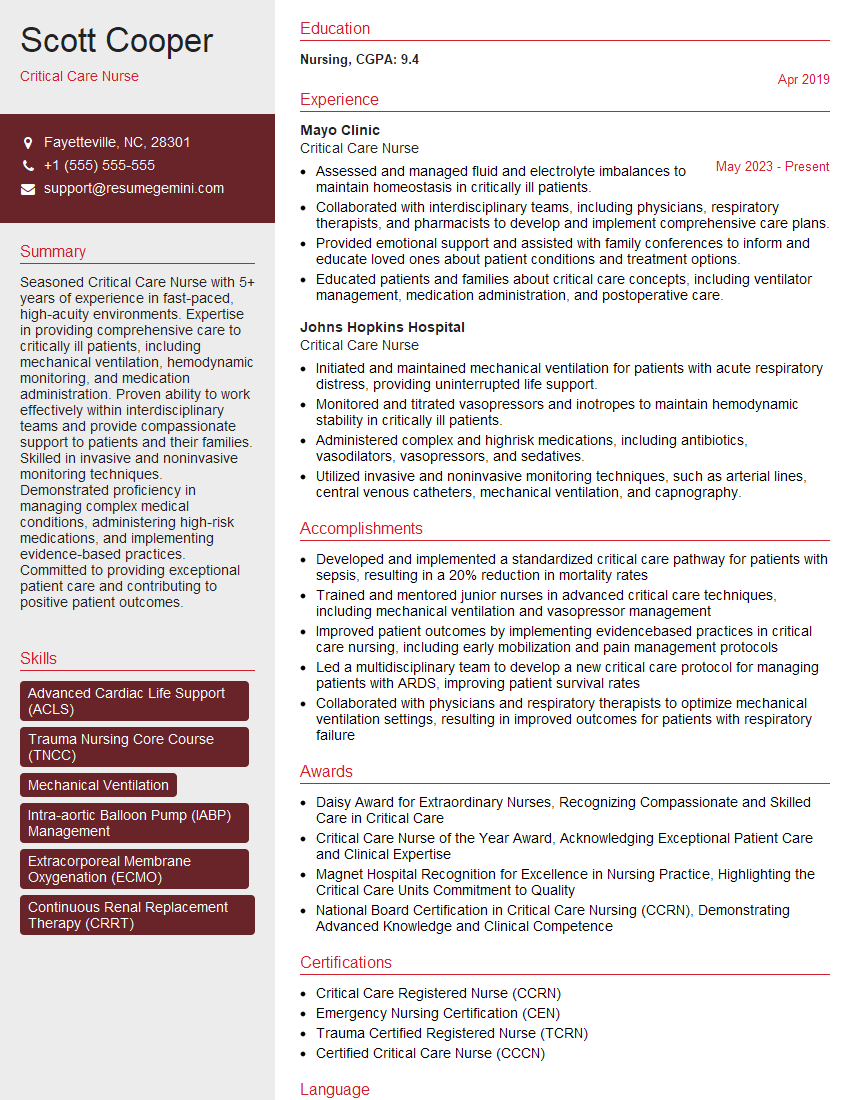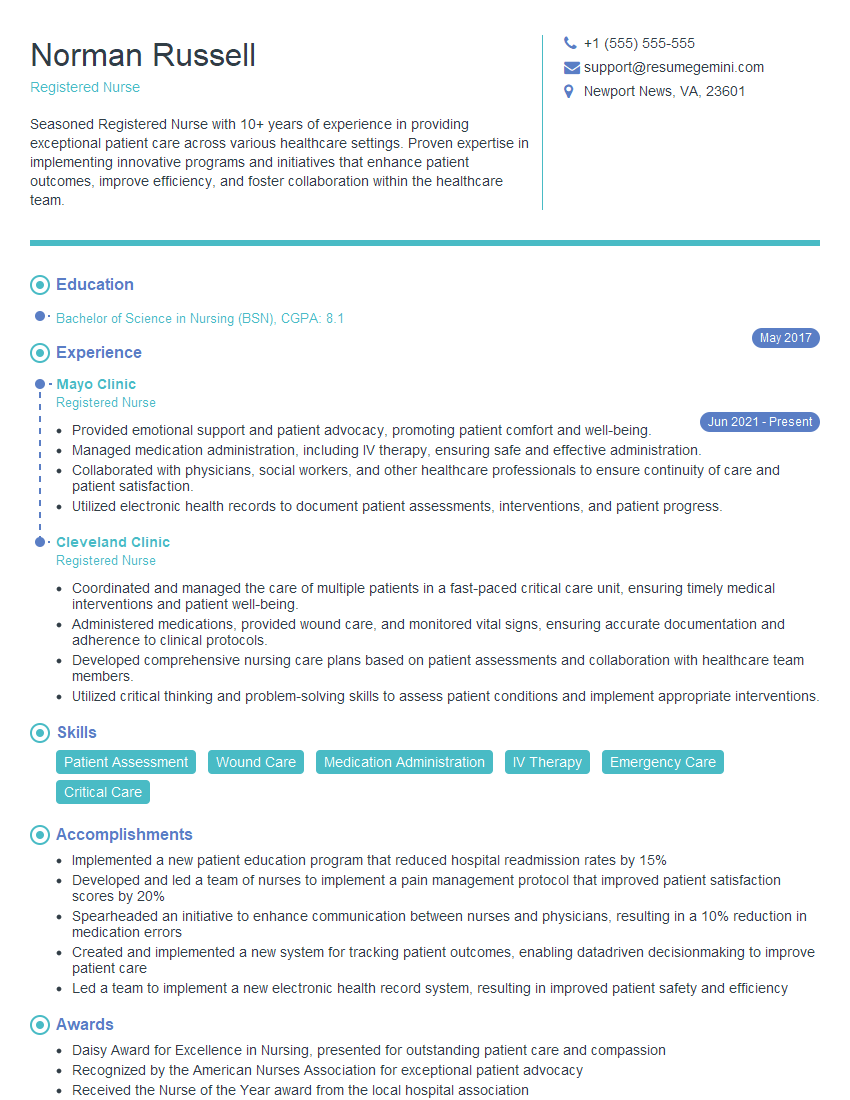Cracking a skill-specific interview, like one for Pleural Effusion Drainage, requires understanding the nuances of the role. In this blog, we present the questions you’re most likely to encounter, along with insights into how to answer them effectively. Let’s ensure you’re ready to make a strong impression.
Questions Asked in Pleural Effusion Drainage Interview
Q 1. Describe the indications for pleural effusion drainage.
Pleural effusion drainage is indicated when a buildup of fluid in the pleural space (the area between the lungs and the chest wall) causes significant respiratory compromise or diagnostic uncertainty. Think of the pleural space like a tiny, crucial gap; when it fills with fluid, it restricts lung expansion.
- Dyspnea (shortness of breath): This is a primary indicator, as fluid restricts lung expansion, making breathing difficult. The severity of dyspnea guides urgency of drainage.
- Hypoxemia (low blood oxygen levels): Fluid in the pleural space reduces the efficiency of gas exchange, leading to low oxygen saturation. This is a serious indication requiring prompt intervention.
- Pleuritic chest pain: Pain worsens with breathing and is often associated with inflammation around the lungs, often a symptom of an underlying condition.
- Diagnostic purposes: If the cause of the effusion isn’t clear, thoracentesis (a procedure to remove fluid) is needed to analyze the fluid’s characteristics (e.g., cytology, microbiology) to diagnose the underlying issue. For instance, is it an infection, cancer, or heart failure?
- Large effusions: Even if the patient is asymptomatic, a very large effusion that occupies a significant portion of the pleural space might require drainage to prevent future complications.
- Tension Pneumothorax: While this is less common with pleural effusion alone, if there’s associated pneumothorax a rapid drainage procedure is vital.
For example, a patient presenting with severe shortness of breath and decreased oxygen saturation alongside a large pleural effusion on imaging would be a strong indication for immediate drainage.
Q 2. What are the contraindications for thoracentesis?
Contraindications to thoracentesis, the procedure to drain pleural fluid using a needle, are situations where the risk of the procedure outweighs the benefits. These include:
- Uncooperative or unsedated patient: Thoracentesis requires the patient to remain still, otherwise the risk of needle injury to lung or other structures is increased.
- Severe coagulopathy: Patients with severe bleeding disorders are at a high risk for significant hemorrhage during the procedure. Correction or modification of anticoagulation might be required.
- Localized infection at the puncture site: Infection at the chosen site increases the risk of introducing the infection into the pleural space.
- Pleural adhesions that are preventing the access of a needle to the fluid: Ultrasound is helpful in identifying areas with minimal adhesions. If multiple attempts fail, another approach (chest tube) might be warranted.
- Severe respiratory distress preventing the patient from cooperating: In this case, the benefit of immediate oxygen support outweighs the risk of delayed thoracentesis. Intubation and mechanical ventilation are priorities.
For instance, a patient with a history of severe bleeding disorders requiring anticoagulants would not be a suitable candidate for thoracentesis without addressing the coagulation issues first.
Q 3. Explain the different methods of pleural effusion drainage.
Several methods exist for pleural effusion drainage, each chosen based on the volume of fluid, the patient’s condition, and the need for ongoing drainage.
- Thoracentesis: This is a relatively simple procedure using a needle inserted under ultrasound guidance to remove fluid. It’s suitable for smaller effusions or diagnostic purposes. Imagine it as a controlled aspiration of the fluid.
- Chest tube insertion: A small tube is inserted into the pleural space to allow for drainage of larger effusions or ongoing drainage over several days. This is more invasive but offers better drainage capacity.
- Video-assisted thoracoscopic surgery (VATS): This minimally invasive surgical technique can be used for complex situations, especially when loculated (trapped) effusions are present or when further surgical intervention is needed (e.g., decortication). This utilizes a small incision and camera.
- Open thoracotomy: This is an open surgical procedure, reserved for rare and complex cases where other methods have failed or immediate and extensive surgical intervention is required.
The choice of method depends on individual factors. For example, a patient with a massive effusion causing respiratory distress would likely benefit from a chest tube, while diagnostic sampling might necessitate thoracentesis.
Q 4. How do you select the appropriate site for thoracentesis?
Site selection for thoracentesis is crucial to minimize risk and maximize effectiveness. It involves identifying an area where the pleural space is readily accessible and away from vital structures.
The procedure typically uses ultrasound guidance to visualize the fluid collection, allowing for precise needle placement. The optimal site is usually in the mid-axillary line (a line drawn vertically through the armpit) between the 7th and 9th intercostal spaces. This area provides adequate distance from major blood vessels and nerves.
It’s essential to avoid areas where the lung is closely adherent to the chest wall. This is determined with ultrasound and careful visual inspection. The process involves careful planning and ultrasound scanning to ensure safe access to the fluid while preventing harm to the patient.
For instance, if the effusion is predominantly in the posterior aspect of the pleural space, the chosen site would reflect that preference. The physician carefully weighs the risks and benefits of various locations. Ultrasound is vital for appropriate site selection.
Q 5. What are the potential complications of thoracentesis?
While generally safe, thoracentesis and chest tube insertion carry potential complications:
- Pneumothorax (collapsed lung): This is the most common complication, occurring when air enters the pleural space. It may manifest as sudden shortness of breath or chest pain.
- Bleeding (hematoma): Injury to blood vessels during needle or tube insertion can cause bleeding into the pleural space or surrounding tissues.
- Infection: Introduction of bacteria into the pleural space can lead to empyema (pus-filled pleural space).
- Re-expansion pulmonary edema: Rapid re-expansion of a collapsed lung after drainage can cause pulmonary edema, potentially life-threatening.
- Injury to surrounding structures: These can include damage to the lung itself, blood vessels, nerves, or adjacent organs.
Careful technique, proper patient selection, and real-time ultrasound guidance help minimize these risks. Post-procedure monitoring is essential to detect and manage any complications promptly. For instance, the post-procedure chest X-ray is crucial to evaluate the presence of a pneumothorax.
Q 6. Describe the procedure for inserting a chest tube.
Chest tube insertion is a more invasive procedure requiring sterile technique and appropriate monitoring. Here’s a step-by-step overview:
- Site selection and preparation: Similar to thoracentesis, ultrasound guidance helps select an appropriate site (usually 5th intercostal space, mid-axillary line) away from major structures. The area is prepared and draped sterily.
- Incision and dissection: A small incision is made through the skin and subcutaneous tissue down to the pleura.
- Tube insertion: A trocar is used to penetrate the pleura and create a passage for the chest tube. The tube is advanced into the pleural space, ensuring adequate placement and drainage.
- Suture fixation: The chest tube is secured in place with sutures.
- Water-seal drainage system connection: The tube is connected to a water-seal drainage system to collect the pleural fluid and prevent air from re-entering the pleural space. This system allows for one-way fluid flow.
- Chest X-ray confirmation: A chest X-ray is performed to confirm appropriate tube placement.
- Post-insertion monitoring: The patient is monitored closely for any signs of complications like bleeding, pneumothorax, or infection.
Throughout this procedure, maintaining a sterile field and close monitoring of the patient’s respiratory status are paramount.
Q 7. How do you manage a pneumothorax during pleural effusion drainage?
Pneumothorax, the presence of air in the pleural space, is a potential complication of pleural effusion drainage. It can occur during needle insertion (thoracentesis) or chest tube insertion. Management depends on the severity:
- Small pneumothorax: Often asymptomatic or causes only mild symptoms. Observation and monitoring with serial chest x-rays are typically sufficient. The pneumothorax may resolve spontaneously.
- Large or symptomatic pneumothorax: If the pneumothorax is large or causing respiratory distress, immediate intervention is required. This might involve needle decompression (inserting a large-bore needle to allow air to escape) followed by chest tube insertion. In severe cases, surgical intervention might be necessary.
- Tension pneumothorax: This life-threatening condition causes progressive collapse of the lung, compromising cardiovascular function. Immediate needle decompression is essential, followed by chest tube placement.
During the procedure itself, the physician remains vigilant for signs of pneumothorax such as sudden changes in respiratory rate or oxygen saturation. The use of ultrasound guidance helps to minimize the risk of inadvertent lung puncture.
Q 8. What are the different types of chest tubes?
Chest tubes come in various sizes and configurations, each designed for specific purposes in pleural effusion drainage. The primary distinction lies in the number of lumens (channels) within the tube.
- Single-lumen chest tubes: These have one lumen, primarily used for drainage. They’re suitable for straightforward cases requiring only fluid removal.
- Double-lumen chest tubes: These have two lumens. One lumen is for drainage, while the other allows for irrigation or the introduction of medications into the pleural space. This is advantageous in cases of complicated effusions with infection or fibrinous material.
- Triple-lumen chest tubes: Less common, these tubes possess three lumens – one for drainage, one for irrigation/medication, and one for continuous pleural pressure monitoring. They are reserved for complex situations requiring precise control.
The choice depends heavily on the clinical scenario. A simple, uncomplicated pleural effusion might only need a single-lumen tube, while a more complex case with a risk of infection or loculated fluid might require a double-lumen tube.
Q 9. How do you select the appropriate size and type of chest tube?
Selecting the appropriate chest tube size and type involves careful consideration of several factors.
- Size: The diameter of the tube is crucial. Larger tubes (e.g., 28-32 French) are used for larger effusions or situations requiring rapid drainage, while smaller tubes (e.g., 16-20 French) are sufficient for smaller effusions or for patients at higher risk of bleeding. The size is usually chosen based on the estimated volume and viscosity of the effusion, along with the patient’s body habitus.
- Type: As discussed earlier, the number of lumens depends on the complexity of the case. A single lumen suffices for uncomplicated cases, while double or triple lumen tubes are chosen for those requiring irrigation or pressure monitoring.
- Patient factors: The patient’s overall health, bleeding risk, and the presence of any other comorbidities are essential considerations. For example, a patient with a coagulopathy might benefit from a smaller tube to minimize bleeding risk.
For example, a patient with a large, uncomplicated parapneumonic effusion might require a 32 French, single-lumen tube for rapid drainage, whereas a patient with a smaller, loculated effusion and a risk of infection might necessitate a 20 French, double-lumen tube for drainage and subsequent instillation of antibiotics.
Q 10. Explain the process of chest tube removal.
Chest tube removal is a relatively straightforward procedure but requires meticulous attention to detail. The steps usually involve:
- Assessment: Assess the patient’s clinical status, chest x-ray findings to ensure adequate lung expansion, and drainage output.
- Preparation: Explain the procedure to the patient, gather supplies (sterile gloves, dressing, suture removal kit), and apply a local anesthetic at the insertion site if necessary.
- Removal: Instruct the patient to perform a Valsalva maneuver (forced exhalation against a closed glottis) and, while holding their breath, quickly remove the chest tube. This reduces the risk of air entering the pleural space.
- Wound care: Apply a sterile occlusive dressing immediately to the insertion site to prevent air leaks.
- Post-procedure monitoring: Closely monitor the patient’s respiratory status and for signs of pneumothorax or other complications.
It’s vital to obtain a chest x-ray post-removal to confirm complete lung expansion and absence of pneumothorax. This confirms the successful completion of the procedure.
Q 11. What are the post-procedural complications of pleural effusion drainage?
Post-procedural complications of pleural effusion drainage can range from minor to life-threatening. They include:
- Bleeding: This can be minor, requiring simple observation or it could be severe, necessitating intervention.
- Pneumothorax: The most common complication, arising from air entering the pleural space during or after tube insertion or removal.
- Infection: Infection at the insertion site or empyema (pus in the pleural space) are potential risks.
- Re-accumulation of effusion: The underlying cause of the effusion needs to be addressed; otherwise, the fluid may reaccumulate.
- Tube malposition: The tube might migrate or become kinked, obstructing drainage.
Careful technique during insertion and removal, diligent monitoring, and prompt management of any complications are essential to minimizing these risks. For example, prophylactic antibiotics might be considered in high-risk patients.
Q 12. How do you monitor patients after pleural effusion drainage?
Post-pleural effusion drainage monitoring is crucial to identify and manage potential complications. Key aspects include:
- Respiratory assessment: Monitor respiratory rate, oxygen saturation, breath sounds, and the patient’s overall respiratory effort. Note any signs of respiratory distress.
- Drainage assessment: Measure and record the volume and character (color, clarity) of the drainage regularly. A sudden increase in drainage volume or a change in character might indicate bleeding or infection.
- Chest x-ray: A chest x-ray is typically obtained immediately post-procedure and then periodically to assess lung expansion and the presence of pneumothorax or other abnormalities.
- Vital signs: Monitor blood pressure, heart rate, and temperature frequently for signs of infection or other complications.
- Pain management: Assess and manage the patient’s pain levels with appropriate analgesics. Pain control is essential for the patient’s comfort and improved recovery.
Imagine a scenario where the drainage suddenly becomes sanguineous (bloody). This immediately raises concern for bleeding, necessitating careful monitoring and potential intervention.
Q 13. Describe the role of imaging in pleural effusion drainage.
Imaging plays a vital role throughout the management of pleural effusions. It’s crucial for diagnosis, guiding intervention, and assessing treatment efficacy.
- Chest x-ray: The initial imaging modality, demonstrating the presence, size, and location of the effusion. It’s also used to guide the placement of the chest tube and to assess lung expansion after drainage.
- Ultrasound: Useful in identifying the optimal insertion site for the chest tube, particularly when the effusion is loculated (compartmentalized) or when the effusion is small. Ultrasound guidance minimizes the risk of lung injury during insertion.
- CT scan: May be used for more complex cases to better visualize the extent of the effusion, identify any underlying pathology, and evaluate for complications.
In essence, imaging is the cornerstone of both diagnosis and monitoring, enabling effective and safe pleural effusion management.
Q 14. How do you interpret a chest x-ray after pleural effusion drainage?
Interpreting a post-drainage chest x-ray involves several key observations:
- Lung expansion: The primary goal is to see complete or near-complete expansion of the lung on the affected side, indicating successful drainage.
- Absence of pneumothorax: Careful examination for the presence of any air in the pleural space is paramount. A pneumothorax would indicate a complication that requires immediate attention.
- Residual effusion: A small amount of residual effusion may be present, particularly after drainage of a large effusion. Its significance depends on its size and the patient’s clinical status.
- Tube position: Confirm the proper positioning of the chest tube, ensuring it’s in the pleural space and not in the lung parenchyma or other structures.
For example, a chest x-ray showing complete lung re-expansion, absence of pneumothorax, and a small amount of residual effusion, along with the patient being asymptomatic, suggests successful drainage. Conversely, a persistent pneumothorax or evidence of significant residual effusion needs further evaluation and intervention.
Q 15. What are the different types of pleural effusions?
Pleural effusions are classified based on their underlying cause and the fluid’s characteristics. They are broadly categorized as:
- Transudative effusions: These are caused by systemic factors that alter hydrostatic or oncotic pressures, leading to a fluid shift into the pleural space. Think of it like a leaky pipe – the system is malfunctioning, causing fluid to accumulate where it shouldn’t. Examples include congestive heart failure, cirrhosis, and nephrotic syndrome.
- Exudative effusions: These result from inflammation or injury to the pleura, disrupting the normal balance of fluid movement. It’s like a wound – the body’s response to injury leads to fluid accumulation. Examples include pneumonia, malignancy, tuberculosis, and pulmonary embolism.
- Empyema: This is a specific type of exudative effusion characterized by the presence of pus. This signifies a severe infection within the pleural space. This is like an infected wound – it needs urgent medical intervention.
- Hemothorax: This effusion is characterized by the presence of blood in the pleural space. This usually occurs after trauma or as a complication of surgery. This is like a severe bleed into the pleural cavity.
- Chylothorax: This is caused by lymphatic fluid leakage into the pleural space. This is a rarer type of pleural effusion and requires specialized management.
Career Expert Tips:
- Ace those interviews! Prepare effectively by reviewing the Top 50 Most Common Interview Questions on ResumeGemini.
- Navigate your job search with confidence! Explore a wide range of Career Tips on ResumeGemini. Learn about common challenges and recommendations to overcome them.
- Craft the perfect resume! Master the Art of Resume Writing with ResumeGemini’s guide. Showcase your unique qualifications and achievements effectively.
- Don’t miss out on holiday savings! Build your dream resume with ResumeGemini’s ATS optimized templates.
Q 16. How do you differentiate between transudative and exudative pleural effusions?
Differentiating between transudative and exudative effusions is crucial for diagnosis and management. Light’s criteria are commonly used. While not foolproof, they provide a useful guideline:
- Light’s criteria: An exudate is suggested if at least one of the following is met:
- Pleural fluid protein/serum protein ratio > 0.5
- Pleural fluid LDH/serum LDH ratio > 0.6
- Pleural fluid LDH > 2/3 the upper limit of normal serum LDH
Transudative effusions typically have low protein and LDH levels, reflecting a passive fluid shift. Exudative effusions, however, present with higher levels due to inflammation and cellular components in the fluid. Imagine comparing clear water (transudate) to muddy water (exudate). The muddy water contains various particles and debris (inflammatory cells, proteins) indicative of the underlying problem.
Further investigations such as pleural fluid analysis (cytology, microbiology, glucose, amylase) are always necessary to pinpoint the exact cause.
Q 17. What is the role of cytology and microbiology in evaluating pleural effusions?
Cytology and microbiology play vital roles in evaluating pleural effusions.
- Cytology: Examination of pleural fluid under a microscope to identify malignant cells. Finding malignant cells confirms the presence of metastatic cancer. This is the cornerstone of diagnosis in suspected malignant effusions. It helps determine if the effusion is due to cancer metastasis.
- Microbiology: This involves culturing the fluid to identify bacteria, fungi, or other microorganisms. It helps identify infectious causes like pneumonia, tuberculosis, or empyema. Identifying the specific pathogen allows for targeted antibiotic therapy.
These tests help differentiate between various causes of pleural effusions, guiding treatment strategies significantly. For instance, finding tuberculosis bacteria requires specific anti-tuberculosis treatment, while detecting malignant cells guides oncologic management.
Q 18. How do you manage a large pleural effusion?
Management of a large pleural effusion depends on its cause and the patient’s clinical status. The primary goal is to relieve respiratory compromise.
- Thoracentesis: This involves removing fluid using a needle inserted under ultrasound or fluoroscopic guidance. This is a relatively quick, low-risk procedure to relieve symptoms immediately. For a large effusion, it may be repeated as needed.
- Indwelling pleural catheter (IPC): This is a catheter placed in the pleural space, allowing for continuous drainage of fluid. This is beneficial for patients with recurrent effusions, or who require frequent drainage.
- Pleurodesis: This procedure aims to permanently close the pleural space to prevent further effusion buildup. Chemical agents like talc or bleomycin are introduced into the pleural cavity to induce inflammation and scarring. This is usually considered for patients with recurrent effusions not responding to other treatments.
Underlying causes also need to be addressed aggressively. For example, if the effusion is due to heart failure, managing the heart failure is critical to preventing recurrence. Similarly, treating pneumonia or tuberculosis is crucial.
Q 19. How do you manage a loculated pleural effusion?
Loculated pleural effusions are pockets of fluid trapped within the pleural space by adhesions or septa. Simple thoracentesis is often ineffective.
- Image-guided catheter drainage: This involves inserting a catheter under ultrasound or CT guidance to drain the loculated fluid. This technique allows for better access to the fluid collection.
- VATS (Video-Assisted Thoracoscopic Surgery): This minimally invasive surgical approach allows direct visualization and drainage of the loculated effusion, as well as removal of any adhesions. It may be the preferred approach when catheter drainage is unsuccessful or if there’s a suspicion of underlying pathology like lung cancer or empyema.
The choice of procedure depends on the size and location of the loculation, the patient’s overall condition, and the availability of resources. If a catheter drainage fails to resolve the effusion, then VATS becomes a valid option.
Q 20. Describe the indications for video-assisted thoracoscopic surgery (VATS) in the management of pleural effusion.
VATS is a minimally invasive surgical technique used to address various pleural diseases. Indications for its use in pleural effusions include:
- Diagnosis of unclear etiology: When thoracentesis is inconclusive in determining the cause of the effusion.
- Loculated pleural effusions: When attempts at catheter drainage fail.
- Empyema: For drainage, debridement, and pleural space management in severe infections.
- Pleural tumors: For biopsy or resection.
- Persistent air leaks: After chest surgery or trauma.
- Failure of medical therapy for recurrent effusions: If pleurodesis fails or is not a feasible option.
VATS offers advantages such as reduced postoperative pain, faster recovery time, and smaller incisions compared to open thoracotomy.
Q 21. What are the advantages and disadvantages of using ultrasound guidance for thoracentesis?
Ultrasound guidance for thoracentesis has significantly improved the safety and efficacy of the procedure.
- Advantages:
- Increased safety: Visualization of the pleural space and surrounding structures minimizes the risk of lung injury, blood vessel puncture, and other complications.
- Improved success rate: Accurate needle placement enhances the yield of fluid obtained.
- Reduced procedure time: Faster identification of the pleural space results in quicker procedure completion.
- Real-time monitoring: Provides immediate feedback on the placement and progress of the procedure.
- Disadvantages:
- Operator dependence: Requires proper training and experience to interpret ultrasound images and perform the procedure correctly.
- Limitations by body habitus: Obesity or other anatomical variations can hinder visualization.
- Equipment costs: Ultrasound machines and probes can be expensive.
In summary, while requiring specialized training, ultrasound-guided thoracentesis offers substantial advantages over blind thoracentesis, making it the preferred technique in most cases.
Q 22. What are the different types of drainage systems used for pleural effusions?
Pleural effusion drainage systems are chosen based on the volume of fluid, the patient’s clinical condition, and the need for ongoing drainage. The most common systems are:
- Closed-pleural drainage system (underwater seal drainage): This is the most frequently used method. A chest tube is inserted into the pleural space, connected to a drainage system with a water seal that prevents air from re-entering the chest cavity. The system typically includes a collection chamber to measure drainage and a suction control chamber to regulate negative pressure, facilitating drainage. Imagine it like a one-way valve for fluid, preventing backflow.
- Heimlich valve: A simpler, portable system ideal for smaller effusions or when immediate access to a sophisticated drainage unit is not available. It’s a one-way valve that allows air and fluid to escape but prevents their re-entry. Think of it as a pressure-release valve.
- Small-bore catheter drainage: This less invasive technique uses a smaller catheter and may be suitable for patients with smaller effusions or those at higher risk of complications from a larger chest tube. Drainage is typically slower compared to larger chest tubes.
The choice of system is a clinical decision made in consideration of the individual patient’s needs.
Q 23. How do you troubleshoot a malfunctioning drainage system?
Troubleshooting a malfunctioning drainage system requires a systematic approach. First, assess the patient for signs of respiratory distress, such as increased shortness of breath or decreased oxygen saturation. Then, carefully inspect the system itself:
- Check for kinks or blockages in the tubing: Gently palpate the tubing for any obstructions. Straightening kinks usually restores drainage.
- Examine the connections: Ensure all connections are secure and airtight. Leaking connections can lead to reduced drainage or air leaks.
- Evaluate the water seal: Fluctuations in the water seal chamber should be seen during inspiration and expiration. The absence of fluctuations could indicate a blockage or air leak in the system.
- Assess suction: If applicable, check that the suction is functioning correctly. Excessive suction can cause lung injury; insufficient suction may impede drainage.
If the problem persists after these checks, notify the physician immediately. Possible interventions include repositioning the chest tube or replacing the drainage system altogether. It’s critical to document all observations and interventions meticulously.
Q 24. Describe the appropriate fluid management strategies for patients with pleural effusions.
Fluid management strategies for pleural effusions depend on the cause, volume, and the patient’s overall condition. Treatment often involves:
- Thoracentesis or Chest Tube Drainage: This removes fluid, improving respiratory function. The volume removed depends on the patient’s tolerance and the presence of any respiratory compromise. Rapid removal of large volumes can cause circulatory problems.
- Pleurodesis: This procedure aims to permanently seal the pleural space, preventing recurrence of effusions. It’s often used for recurrent effusions or malignant effusions. This involves introducing a chemical irritant into the pleural space to induce inflammation and adhesion between the parietal and visceral pleurae.
- Treating the underlying cause: Addressing the root cause of the effusion, whether it’s heart failure, pneumonia, cancer, or another condition, is crucial for long-term management. For example, treating congestive heart failure will likely reduce the effusion.
- Monitoring vital signs: Close monitoring of vital signs, including respiratory rate, heart rate, blood pressure, and oxygen saturation, is essential throughout the drainage process.
Careful fluid balance is critical; too rapid removal can lead to hypotension and electrolyte imbalances. Regular assessment and adjustment of treatment are needed based on the patient’s response.
Q 25. What are the signs and symptoms of pleural effusion?
The signs and symptoms of pleural effusion can vary depending on the size and cause of the effusion. Smaller effusions may be asymptomatic, while larger effusions can cause:
- Shortness of breath (dyspnea): This is a common symptom, especially with exertion. The fluid compresses the lungs, reducing their ability to expand.
- Chest pain: This pain is often sharp or stabbing and may worsen with deep breaths or coughing. It’s caused by inflammation or irritation of the pleura.
- Cough: A dry or productive cough may be present. This is due to irritation of the lung and airways.
- Fatigue: Reduced oxygenation due to lung compression leads to fatigue and decreased exercise tolerance.
- Rapid heart rate (tachycardia): The body compensates for reduced oxygenation by increasing the heart rate.
- Reduced breath sounds: The presence of fluid can reduce the clarity of breath sounds on auscultation (listening to the chest with a stethoscope).
These symptoms may be subtle initially, but they can progress significantly with larger effusions.
Q 26. How do you interpret the results of pleural fluid analysis?
Pleural fluid analysis provides critical information for diagnosing the cause of the effusion. The key aspects are:
- Appearance: The fluid’s clarity (serous, bloody, purulent) gives clues about the underlying condition. For example, a cloudy or purulent appearance suggests infection.
- Cell count and differential: This helps identify the presence of inflammatory cells (infection), malignant cells (cancer), or other cell types.
- Protein and lactate dehydrogenase (LDH) levels: Elevated levels of these indicate increased permeability of the pleural membrane, suggesting conditions like heart failure or cancer.
- Glucose levels: Low glucose levels may indicate infection or malignancy.
- pH: Low pH is suggestive of infection or malignancy.
- Microbiological analysis: Culture and Gram stain are used to identify bacteria or other microorganisms in cases of suspected infection.
- Cytology: Microscopic examination of the fluid can identify malignant cells, aiding cancer diagnosis.
Interpreting these results requires a comprehensive understanding of the clinical context. The findings are often combined with chest x-ray, CT scan, and other diagnostic tests to establish a definitive diagnosis.
Q 27. What are the potential long-term complications of untreated pleural effusions?
Untreated pleural effusions can lead to several serious long-term complications:
- Respiratory failure: Large effusions can severely compromise lung function, leading to hypoxemia (low blood oxygen) and respiratory failure, requiring mechanical ventilation.
- Infection (empyema): A pleural effusion can become infected, forming an empyema, which requires aggressive antibiotic treatment and often drainage.
- Lung compression and atelectasis: The compressed lung can collapse (atelectasis) leading to permanent damage.
- Chronic pain: Persistent pleural inflammation can result in chronic pain.
- Cor pulmonale: Chronic lung disease from untreated effusion can lead to right-sided heart failure.
The severity of these complications depends on the underlying cause of the effusion and the duration of the untreated condition.
Q 28. How do you counsel patients about the risks and benefits of pleural effusion drainage?
Counseling patients about pleural effusion drainage involves a clear and empathetic explanation of the procedure, its risks, and its benefits. I usually approach it this way:
- Explain the diagnosis and its implications: Use simple language to describe the condition and its effect on breathing. Provide analogies to make the concept easier to understand. For example, I might compare the fluid to water filling a balloon, reducing its ability to inflate.
- Describe the procedure: Explain the process of thoracentesis or chest tube placement, highlighting the steps involved and any sensations the patient might experience. Reassure patients that pain relief is provided.
- Discuss the risks and benefits: Be open and honest about potential risks, such as bleeding, infection, pneumothorax (collapsed lung), and pain. However, I also emphasize the benefits, such as improved breathing and reduced discomfort.
- Address patient concerns: Actively listen to the patient’s questions and concerns and provide honest and straightforward answers. Answer in a way they can understand, using non-medical jargon when possible.
- Follow-up care: Explain the post-procedure care, including wound care, pain management, and follow-up appointments.
Patient education and reassurance are vital for a positive experience. Building a strong patient-physician relationship can increase patient compliance and improve outcomes.
Key Topics to Learn for Pleural Effusion Drainage Interview
- Anatomy and Physiology of the Pleura: Understand the normal anatomy and physiology of the pleural space, including the visceral and parietal pleura, and the mechanisms of pleural fluid formation and absorption.
- Types of Pleural Effusions: Differentiate between transudative and exudative effusions, and understand the clinical significance of each type. Consider the underlying etiologies.
- Diagnosis of Pleural Effusions: Be familiar with diagnostic techniques like chest x-ray interpretation, ultrasound-guided thoracentesis, and the analysis of pleural fluid (e.g., cytology, biochemistry).
- Indications for Drainage: Know the indications and contraindications for pleural effusion drainage, considering factors such as respiratory compromise, infection, and the nature of the effusion.
- Drainage Techniques: Master the different methods of pleural effusion drainage, including thoracentesis, chest tube insertion, and the management of complications.
- Practical Application: Be prepared to discuss case studies, troubleshooting common problems during drainage procedures (e.g., bleeding, air leak), and post-procedure management.
- Complications and Management: Understand potential complications such as pneumothorax, bleeding, infection, and re-accumulation, and how to manage them effectively.
- Imaging Interpretation: Be able to interpret chest x-rays and ultrasound images related to pleural effusions and drainage procedures.
- Evidence-Based Practice: Familiarize yourself with the latest guidelines and research on pleural effusion management.
Next Steps
Mastering Pleural Effusion Drainage is crucial for career advancement in respiratory care and related fields. A strong understanding of this procedure demonstrates critical thinking, technical skill, and patient management abilities, highly valued by employers. To enhance your job prospects, create an ATS-friendly resume that showcases your expertise effectively. ResumeGemini is a trusted resource that can help you build a professional and impactful resume tailored to the healthcare industry. Examples of resumes specifically tailored for candidates with expertise in Pleural Effusion Drainage are available for your review to guide your resume creation.
Explore more articles
Users Rating of Our Blogs
Share Your Experience
We value your feedback! Please rate our content and share your thoughts (optional).
What Readers Say About Our Blog
Hello,
We found issues with your domain’s email setup that may be sending your messages to spam or blocking them completely. InboxShield Mini shows you how to fix it in minutes — no tech skills required.
Scan your domain now for details: https://inboxshield-mini.com/
— Adam @ InboxShield Mini
Reply STOP to unsubscribe
Hi, are you owner of interviewgemini.com? What if I told you I could help you find extra time in your schedule, reconnect with leads you didn’t even realize you missed, and bring in more “I want to work with you” conversations, without increasing your ad spend or hiring a full-time employee?
All with a flexible, budget-friendly service that could easily pay for itself. Sounds good?
Would it be nice to jump on a quick 10-minute call so I can show you exactly how we make this work?
Best,
Hapei
Marketing Director
Hey, I know you’re the owner of interviewgemini.com. I’ll be quick.
Fundraising for your business is tough and time-consuming. We make it easier by guaranteeing two private investor meetings each month, for six months. No demos, no pitch events – just direct introductions to active investors matched to your startup.
If youR17;re raising, this could help you build real momentum. Want me to send more info?
Hi, I represent an SEO company that specialises in getting you AI citations and higher rankings on Google. I’d like to offer you a 100% free SEO audit for your website. Would you be interested?
Hi, I represent an SEO company that specialises in getting you AI citations and higher rankings on Google. I’d like to offer you a 100% free SEO audit for your website. Would you be interested?
good
